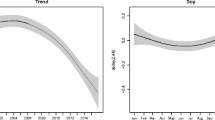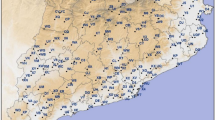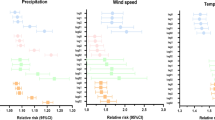Abstract
This study aims to systematically review epidemiological studies that evaluate the relationship between meteorology and the incidence of hip fracture (HF). After a search in Scopus, PubMed, and Embase, two independent authors assessed the relevance of studies and extracted data for description. From each study, we extracted the geographic and temporal scope, design, study variables (meteorological and related to HF), statistical analysis, and estimated associations. Of a total of 134 works, 20 studies were selected. All use an ecological design but one case-crossover. Most studies have been conducted in northern latitudes. The analysis methodology did not take into account the temporal structure of the data in 10 studies (regression and linear correlations); the rest used Poisson regression (7) and ARIMA model (3). Most studies showed significant positive associations with rainfall, especially in the form of snow: HF relative risk (RR) on days with precipitation vs. days without precipitation that ranged from 1.14 (95 % confidence interval (CI)1.04 to 1.24) to 1.60 (95 % CI 1.06 to 2.41), the temperature, with RR by one degree Celsius decline from 1.012 (95 % CI 1.004 to 1.020) to 1.030 (95 % CI 1.023 to 1.037), and wind (3) RR FC windiest days vs. calm days: 1.32 (95 % CI 1.10 to 1.58) to 1.35 (95 % CI 0.88 to 2.08). This review shows that analytic methods are very heterogeneous and poorly adapted to the temporary nature of the data. Studies confirm a certain seasonality, with more fractures in winter and meaningful relationships with meteorological conditions typical of this season.


Similar content being viewed by others
References
Aaron JE, Gallagher JC, Nordin BE (1974) Seasonal variation of histological osteomalacia in femoral-neck fractures. Lancet 2:84–85
Atherton WG, Harper WM, Abrams KR (2005) A year’s trauma admissions and the effect of the weather. Injury 36:40–46
Bastow MD, Rawlings J, Allison SP (1983) Undernutrition, hypothermia, and injury in elderly women with fractured femur: an injury response to altered metabolism? Lancet 1:143–146
BCMA B. C. M. A. (2013) Osteoporosis: diagnosis, treatment and fracture prevention, p 17. Retrieved from http://www.bcguidelines.ca/pdf/osteoporosis.pdf
Beynon C, Wyke S, Jarman I et al (2011) The cost of emergency hospital admissions for falls on snow and ice in England during winter 2009/10: a cross sectional analysis. Environ Health 10:60
Bischoff-Ferrari HA (2012) Vitamin D and fracture prevention. Rheum Dis Clin North Am 38:107–113
Bischoff-Ferrari HA, Orav JE, Barrett JA, Baron JA (2007) Effect of seasonality and weather on fracture risk in individuals 65 years and older. Osteoporos Int 18:1225–1233
Bischoff-Ferrari HA, Can U, Staehelin HB et al (2008) Severe vitamin D deficiency in Swiss hip fracture patients. Bone 42:597–602
Bischoff-Ferrari HA, Dawson-Hughes B, Whiting SJ (2011) Vitamin D supplementation and fracture risk. Arch Intern Med 171:265
Bulajic-Kopjar M (2000) Seasonal variations in incidence of fractures among elderly people. Inj Prev 6:16–19
Burget F, Pleva L, Kudrna K, Kudrnová Z (2012) Incidence of proximal femur fractures in relation to seasons of the year and weather. Acta Chir Orthop Traumatol Cech 79:140–143
Caniggia M, Morreale P (1989) Epidemiology of hip fractures in Siena, Italy, 1975–1985. Clin Orthop Relat Res 131–138
Carter MI, Hinton PS (2014) Physical activity and bone health. Mo Med 111:59–64
CASPe. Critical Appraisal Skills Programme Español. http://www.redcaspe.org/drupal/. Accessed 3 June 2013
Chesser TJS, Howlett I, Ward AJ, Pounsford JC (2002) The influence of outside temperature and season on the incidence of hip fractures in patients over the age of 65. Age Ageing 31:343–348
Chiu KY, Ng TP, Chow SP (1996) Seasonal variation of fractures of the hip in elderly persons. Injury 27:333–336
Cinar N, Harmanci A, Yildiz BO, Bayraktar M (2014) Vitamin D status and seasonal changes in plasma concentrations of 25-hydroxyvitamin D in office workers in Ankara, Turkey. Eur J Intern Med 25:197–201
Crawford JR, Parker MJ (2003) Seasonal variation of proximal femoral fractures in the United Kingdom. Injury 34:223–225
Dennison E, Mohamed MA, Cooper C (2006) Epidemiology of osteoporosis. Rheum Dis Clin North Am 32:617–629
Douglas AS (1993) Seasonality of hip fracture and haemorrhagic disease of the newborn. Scott Med J 38:37–40
Frihagen F, Pleva L, Kudrna K, Kudrnova Z (2011) Ice and snow in Oslo gave a marked increase in distal radius fractures, but not hip fractures. Osteoporos Int 22:S169–S170
Furelos M, Colino AL, Trobajo JE, Quevedo LA (2001) Hip fractures, seasonal variations and influence of climatological parameters. Rev Ortop Traumatol 45:384–388
Jacobsen SJ, Sargent DJ, Atkinson EJ et al (1995) Population-based study of the contribution of weather to hip fracture seasonality. Am J Epidemiol 141:79–83
Kanis JA, Borgström F, Compston J et al (2013) SCOPE: a scorecard for osteoporosis in Europe. Arch Osteoporos 8:144
Katsouyanni K, Schwartz J, Spix C et al (1996) Short term effects of air pollution on health: a European approach using epidemiologic time series data: the APHEA protocol. J Epidemiol Community Health 50(Suppl 1):S12–S18
Lau EM, Gillespie BG, Valenti L, O’Connell D (1995) The seasonality of hip fracture and its relationship with weather conditions in New South Wales. Aust J Public Health 19:76–80
Lauritzen JB, Schwarz P, McNair P et al (1993) Radial and humeral fractures as predictors of subsequent hip, radial or humeral fractures in women, and their seasonal variation. Osteoporos Int 3:133–137
Levy AR, Bensimon DR, Mayo NE, Leighton HG (1998) Inclement weather and the risk of hip fracture. Epidemiology 9:172–177
Lin H-C, Xiraxagar S (2006) Seasonality of hip fractures and estimates of season-attributable effects: a multivariate ARIMA analysis of population-based data. Osteoporos Int 17:795–806
Lips P (2001) Vitamin D deficiency and secondary hyperparathyroidism in the elderly: consequences for bone loss and fractures and therapeutic implications. Endocr Rev 22:477–501
Lofthus CM, Osnes EK, Falch JA et al (2001) Epidemiology of hip fractures in Oslo, Norway. Bone 29:413–418
Mirchandani S, Aharonoff GB, Hiebert R et al (2005) The effects of weather and seasonality on hip fracture incidence in older adults. Orthopedics 28:149–155
Modarres R, Ouarda TBMJ, Vanasse A et al (2012) Modeling seasonal variation of hip fracture in Montreal, Canada. Bone 50:909–916
Modarres R, Ouarda TBMJ, Vanasse A et al (2014) Modeling climate effects on hip fracture rate by the multivariate GARCH model in Montreal region, Canada. Int J Biometeorol 58:921–930
Moher D, Liberati A, Tetzlaff J, Altman DG, PRISMA Group (2009) Preferred reporting items for systematic reviews and meta-analyses: the PRISMA statement. Ann Intern Med 151:264–269
Morency P, Voyer C, Burrows S, Goudreau S (2012) Outdoor falls in an urban context: winter weather impacts and geographical variations. Can J Public Health 103:218–222
Morgan SL (2013) Dietary supplements and medical foods for osteopenia and osteoporosis. J Clin Densitom 16:394–401
Morgenstern H (1995) Ecologic studies in epidemiology: concepts, principles, and methods. Annu Rev Public Health 16:61–81
Murray IR, Howie CR, Biant LC (2011) Severe weather warnings predict fracture epidemics. Injury 42:687–690
(NAMS), N. A. M (2010) Management of osteoporosis in postmenopausal women: 2010 position statement of The North American Menopause Society. Menopause (New York, NY) 17(1):25–54. doi:10.1097/gme.0b013e3181c617e6
Parker MJ, Martin S (1994) Falls, hip fractures and the weather. Eur J Epidemiol 10:441–442
Parker MJ, Twemlow TR, Pryor GA (1996) Environmental hazards and hip fractures. Age Ageing 25:322–325
Pasco JA, Henry MJ, Kotowicz MA et al (2004) Seasonal periodicity of serum vitamin D and parathyroid hormone, bone resorption, and fractures: the Geelong Osteoporosis Study. J Bone Miner Res 19:752–758
Romley JA, Jena AB, O'Leary JF, Goldman DP (2013) Spending and mortality in US acute care hospitals. Am J Manag Care 19:e46–e54
Rothman KJ (2012) What is causation? In: Rothman KJ (ed) Epidemiology: an introduction. Oxford University Press, Oxford, p 282
Schneider EL, Guralnik JM (1990) The aging of America. Impact on health care costs. JAMA 263:2335–2340
Stroup DF, Berlin JA, Morton SC et al (2000) Meta-analysis of observational studies in epidemiology: a proposal for reporting. Meta-analysis of Observational Studies in Epidemiology (MOOSE) group. JAMA 283:2008–2012
Tenías JM, Estarlich M, Fuentes-Leonarte V et al (2009) Short-term relationship between meteorological variables and hip fractures: an analysis carried out in a health area of the Autonomous Region of Valencia, Spain (1996–2005). Bone 45:794–798
Turner RM, Hayen A, Dunsmuir WTM, Finch CF (2011) Air temperature and the incidence of fall-related hip fracture hospitalisations in older people. Osteoporos Int 22:1183–1189
Author information
Authors and Affiliations
Corresponding author
Rights and permissions
About this article
Cite this article
Román Ortiz, C., Tenías, J.M., Estarlich, M. et al. Systematic review of the association between climate and hip fractures. Int J Biometeorol 59, 1511–1522 (2015). https://doi.org/10.1007/s00484-014-0945-y
Received:
Revised:
Accepted:
Published:
Issue Date:
DOI: https://doi.org/10.1007/s00484-014-0945-y




